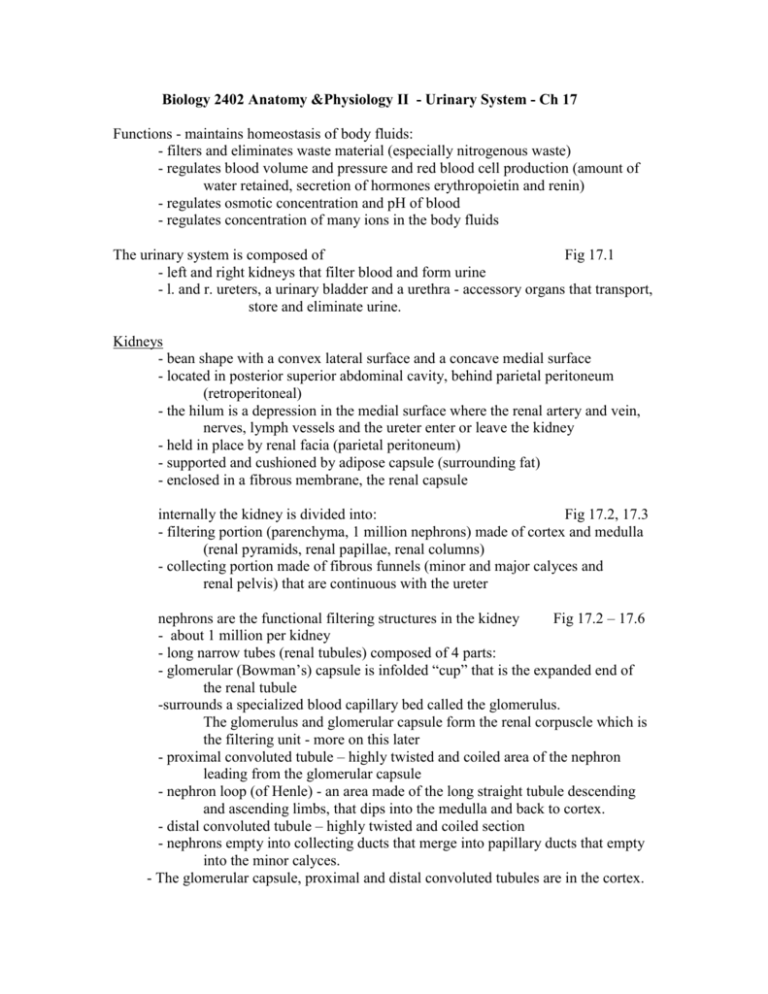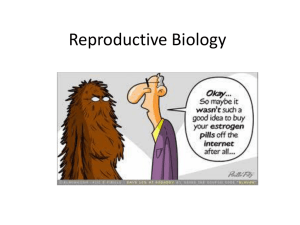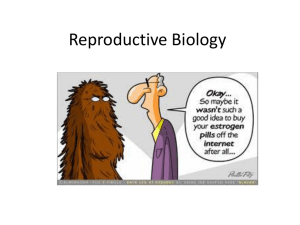Biology 2402 Anatomy &Physiology II - Urinary System
advertisement

Biology 2402 Anatomy &Physiology II - Urinary System - Ch 17 Functions - maintains homeostasis of body fluids: - filters and eliminates waste material (especially nitrogenous waste) - regulates blood volume and pressure and red blood cell production (amount of water retained, secretion of hormones erythropoietin and renin) - regulates osmotic concentration and pH of blood - regulates concentration of many ions in the body fluids The urinary system is composed of Fig 17.1 - left and right kidneys that filter blood and form urine - l. and r. ureters, a urinary bladder and a urethra - accessory organs that transport, store and eliminate urine. Kidneys - bean shape with a convex lateral surface and a concave medial surface - located in posterior superior abdominal cavity, behind parietal peritoneum (retroperitoneal) - the hilum is a depression in the medial surface where the renal artery and vein, nerves, lymph vessels and the ureter enter or leave the kidney - held in place by renal facia (parietal peritoneum) - supported and cushioned by adipose capsule (surrounding fat) - enclosed in a fibrous membrane, the renal capsule internally the kidney is divided into: Fig 17.2, 17.3 - filtering portion (parenchyma, 1 million nephrons) made of cortex and medulla (renal pyramids, renal papillae, renal columns) - collecting portion made of fibrous funnels (minor and major calyces and renal pelvis) that are continuous with the ureter nephrons are the functional filtering structures in the kidney Fig 17.2 – 17.6 - about 1 million per kidney - long narrow tubes (renal tubules) composed of 4 parts: - glomerular (Bowman’s) capsule is infolded “cup” that is the expanded end of the renal tubule -surrounds a specialized blood capillary bed called the glomerulus. The glomerulus and glomerular capsule form the renal corpuscle which is the filtering unit - more on this later - proximal convoluted tubule – highly twisted and coiled area of the nephron leading from the glomerular capsule - nephron loop (of Henle) - an area made of the long straight tubule descending and ascending limbs, that dips into the medulla and back to cortex. - distal convoluted tubule – highly twisted and coiled section - nephrons empty into collecting ducts that merge into papillary ducts that empty into the minor calyces. - The glomerular capsule, proximal and distal convoluted tubules are in the cortex. Juxtaglomerular apparatus is group of cells between glomerular capsule and convoluted tubule - produces renin and hormones - sensitive to low blood pressure. Fig 17.7 Blood supply to the kidney and nephron (20-25% of resting cardiac output; 1.2 L/min) renal artery --> smaller arteries branch throughout kidney --> afferent arteriole --> glomerulus --> efferent arteriole --> peritubular capillary --> smaller veins that merge throughout kidney --> renal vein Fig 17.3 , 17.6 * What is the function of the peritubular capillary bed? Urine formation Fig 17.7 – 17.14 - involves three processes: filtration, tubular reabsorption and tubular secretion - filtration of blood occurs in the renal corpuscle - the filtration membrane consists of the glomerulus endothelium (fenestrated), a fibrous basement membrane and the specialized cells of the Bowman’s capsule (podocytes). - water and molecules smaller than proteins are forced out by blood pressure ( 20% of blood, 180liters/day) - the filtrate. (about 1-2 L urinated/day) - filtration pressure is increased by constriction of efferent arteriole and dilation of afferent arteriole - local regulation. - drop in blood pressure causes juxtaglomerular apparatus to release renin - renin causes blood pressure to increase via angiotensin pathway to raise blood pressure by ADH secretion, aldosterone secretion, vasoconstriction - most valuable molecules (glucose, amino acids, vitamins, sodium and other ions) are actively transported out of proximal convoluted tubule; water follows passively by osmosis (60-70% of filtrate). - other molecules (some organic molecules, H+ , ammonia) actively secreted into tubule, especially in distal convoluted tubule - aldosterone stimulates Na+ retention and K+ secretion in dct to fine tune balance - the descending limb of the nephron loop (of Henle) is permeable to water but not solutes; about half of the water left in filtrate osmosis out. - the ascending limb is impermeable to water and solutes. However, Na+ and Clions are actively pumped out into the medulla. This builds a concentration gradient in the medulla, more concentrated in deep medulla. - the collecting ducts are impermeable to solutes and water. The presence of antidiuretic hormone (ADH) makes the collecting ducts permeable to water. Because of the concentration gradient in the medulla water will osmosis out if the cells are permeable. Without ADH the urine is dilute, with ADH the urine is more concentrated (4-5 times as blood, up to 99% of water recovered) - urine is not modified after it leaves the collecting ducts in the medulla. Urine passes from collecting ducts through openings in renal papillae into collecting portion of kidney: minor calyx -> major calyx -> renal pelvis -> ureter ureters carry urine to urinary bladder - three layer (mucosa is inner, muscle middle, and fibrous outer) - peristalsis moves urine. Fig 17.15 urinary bladder stores urine, located retroperitoneal. Fig 17.1, 17.16 - mucosa is made of transitional epithelium, has rugae - allow for expansion. - muscle layer of smooth muscle with fibers in all directions - detrusor muscle - internal urethral sphincter is of smooth muscle (involuntary) and the external urethral sphincter is of skeletal muscle (voluntary) - micturition reflex is spinal reflex – stretch receptors in bladder wall stimulate detrusor muscle to contract and internal and external urethral sphincters to relax - external urethral sphincter of skeletal muscle under conscious control can temporarily block micturition urethra carries urine to the exterior (urethral orifice) - same layers as ureters - short in female, to vestibule between labia; - longer in male , through penis (also serves as semen pathway in males) Biology 2402 Anatomy & Physiology II - Reproductive System - Ch 19 Gamete (sex cell) formation in testes in males (spermatogenesis) and in ovaries in females (oogenesis) - from stem cells (spermatogonia or oogonia). Fig 19.3, 19.8 Process of meiosis reduces the number of chromosomes from 46 to 23 in humans. In males spermatogonia begin dividing at puberty and continue as stem cells for life. In females oogonia divide before birth and become inactive. At puberty primary oocytes (400,000 on hand) begin developing but no stem cells; menarche to menopause Spermatids mature into small mobile sperm, secondary oocytes mature into large immobile ova. *Why and how do eggs become larger than sperm? What are polar bodies? Male reproductive system Testes are male gonads that produce sperm; enclosed in scrotum Fig 19.1 - the scrotum is a cavity outside of the abdominal cavity (this reduces the temperature- high temperature affects sperm development) - testes descend from abdominal cavity into scrotum before birth. - spermatic cord is a connective tissue sheath that connects the scrotal cavity with the abdominal cavity through the inguinal canal; it contains blood vessels, lymph vessels, nerve and vas deferens. - scrotum is divided into two cavities lined with serous membrane (1 testis per cavity) which is extension of parietal peritoneum - cremaster muscle forms layer beneath skin of scrotum which can position testes; when cremaster muscle contracts testes are pulled closer to body for warmth, when relaxed testes drop further from body to cool. - each testis is covered by a serous membrane and a fibrous capsule. Extensions of the capsule inward divide the testis into lobules. - sperm production (spermatogenesis) occurs along a highly branched and coiled tube called the seminiferous tubules (almost 1 mile in testes - WOW). - spermatogonia line the seminiferous tubules and developing spermatids are pushed to the center (lumen) of the tubules (sperm flow from these). - sustentacular cells (also called supporting cells or nurse cells) surround the developing sperm and protect and nourish them; form blood-testis barrier and regulate growth. Fig 19.2, 19.4 - interstitial endocrinocytes (interstitial cells) are located between seminiferous tubules and produce male sex hormones (androgens like testosterone). The reproductive tract is a series of tubes that store and transport sperm and allow sperm to mature - form accessory structures. Sperm moved by peristalsis. Fig 19.1 - epididymis - coiled tube adjacent to testis in scrotal cavity (6 m long, 2 weeks) continuous with seminiferous tubules - sperm complete development -vas deferens (ductus deferens) is a tube from each scrotal cavity that carries sperm from epeididymis into abdominal cavity; store sperm up to several months - ejaculatory duct - short tube beginning at junction of vas deferens and duct from seminal vesicle. Left and right ejaculatory ducts merge and enter urethra in prostate gland. - urethra - tube from urinary bladder through penis; also sperm and semen transport. * Follow the sperm from the point of production to the exterior. * What is the function of the cremaster muscle? Why is this important? Accessory glands secrete seminal fluid which mixes with sperm to form semen. - nourishes, transports, activates and protects sperm; 2-5 ml per ejaculation. - seminal vesicles (paired) secrete 60% of semen; fructose (nourish sperm), alkaline pH buffer (neutralize acids in urethra and vagina), clotting factors, enzymes that activate sperm and stimulate muscles within female tract . - prostate gland (single donut-shaped gland surrounding urethra below urinary bladder) secretes 30% of semen; clotting factors, enzymes that activate sperm, antibiotic, pH buffers. - bulbourethral glands (paired; also called Cowper’s glands) secrete 5% of semen; thick alkaline mucus as a lubricant; into urethra below prostate. *List the male accessory glands and describe 4 secretions they produce. *Where does each of these enter the reproductive tract. Penis is organ containing erectile tissue that can enlarge and become rigid (erection) to place sperm in female reproductive tract (intercourse). - root attaches penis to the body wall - body of penis contains 3 columns of erectile tissue, corpus spongiosum and 2 corpora cavernosa. Urethra located in corpus spongiosum. - expanded tip (glans) is highly innervated (nerve endings) and is covered by a sheath-like fold of skin (prepuce - removed by circumcision) Sexual arousal and intercourse (coitus, copulation) - arousal by psychic and tactile stimulation; parasympathetic stimulation - erectile tissue expands as arteries in are dilated, which compresses vein. Artery and vein pass through a nonstretchable collar. Blood therefore accumulates in tissue causing it to expand - erection. - emission and ejaculation of semen by peristalsis from accessory glands and sperm from some point along vas deferens; sympathetic stimulation - orgasm is psychic release, intense pleasurable feelings Regulation of male reproductive system. (Always have enough sperm, don’t explode) - gonadotropin-releasing hormones - from hypothalamus, stimulate anterior pituitary - follicle stimulating hormone - from ant. pituitary, stimulates supporting cells and spermatogonia to produce sperm Fig 19.6 - luteinizing - from ant. pituitary, stimulates interstitial cells to produce testosterone - inhibin - from supporting cells, inhibits anterior pituitary to block FSH - testosterone - from interstitial cells, stimulates development of sex organs and secondary sexual characteristics (body hair, muscle and bone growth, vocal chords, etc.). high level of testosterone inhibits hypothalamus and anterior pituitary. *Describe the hormonal control of the male reproductive system. Female reproductive system Fig 19.7 Ovaries are female gonads, enclosed in a fibrous capsule in lower abdominal cavity, that produce eggs (ova) by oogenesis. The cyclic egg production is called the ovarian cycle. - oogonia (stem cells) divide to form primary oocytes then die before birth. - at puberty about 200,000 primary oocytes per ovary are present Fig 19.9 - a primary oocyte enclosed in a layer of follicle cells forms a primordial follicle - each cycle about 20 of the primordial follicles begin to develop into primary follicles (this is influenced by hormones - more on this later) - as the follicles grow open spaces develop within the follicle and the follicular cells begin to produce estrogens - as the follicle reaches maximum size it is called a tertiary or Graafian follicle and has a large fluid filled area with the oocyte in the center - at ovulation the tertiary follicle fuses with the capsule and ruptures, releasing the oocyte from the ovary (about 14 days after beginning development) - the empty follicle then becomes the corpus luteum, which begins producing the hormones progesterone and inhibin. The corpus luteum dies within about 12 days if the egg is not fertilized. *Describe the ovarian cycle, including the hormones that initiate it and are produced. uterine tubes (fallopian tubes, oviducts) transport ova that have ovulated to uterus - open proximal end forms funnel-like infundibulum around ovary Fig 19.11 - finger-like fimbriae on rim of infundibulum help sweep ovum into oviduct. - cilia lining of oviduct and peristalsis move ovum along oviduct to uterus - 3-4 days or longer normally required to move ovum to uterus but fertilization must occur within 12 - 24 hours after ovulation; therefore fertilization must occur in upper oviduct (sperm must reach this point). uterus is muscular chamber that supports and nourishes fertilized ovum and developing fetus and embryo. - uterine body is large central chamber (about superior 2/3) - cervix is muscular inferior neck; contracts to maintain embryo in uterus - uterus made of 3 layers: perimetrium is outer layer of serous membrane; myometrium is thick smooth muscle middle layer; and endometrium is inner lining that forms supporting structure for fertilized ovum. Fig 19.12 - endometrium composed of deep base layer that remains about the same size and a surface layer (functional zone) that is produced and dies each uterine cycle. This is material that is lost during menses. - the uterine cycle (menstrual cycle) is the building and destruction of the functional layer and usually is about 28 days; from puberty to menopause. - the cycle begins with menses, or menstruation, during which time (about 4 days) the functional layer of the endometrium is ejected - the proliferation phase then begins as estrogen level increases and the functional layer begins to produce new cells, blood vessels and glands (9 days) - the secretory phase begins at ovulation and is stimulated by estrogen and especially rising levels of progesterone. Endometrial glands secrete glucose rich mucus and other compounds preparing for arrival of fertilized ovum. - as progesterone level drop (after about 12 days) the functional layer begins to die and menses begins a few days later. - cervical mucus glands produce cervical mucus that lubricates vagina during sexual intercourse and forms cervical plug. *Describe the cyclic events that occur in the uterus and explain which hormones are involved and what each hormone affects. vagina is the receptacle for the penis and semen during intercourse (coitus), transports uterine secretions and is the birth canal for the fetus. - rugae and layers of smooth muscle allow considerable stretch, epithelium of stratified squamous epithelium - breakdown of organic molecules produces acidic environment to decrease growth of invading organisms. vulva (external genitalia, pudendum) are the external accessory organs - 2 folds (labia minora and labia majora) form central vestibule, into which vagina and urethra open; ends in mons pubis fatty mound anterior to vestibule; contain erectile tissue homologous to corpora cavernosa in males. - clitoris is similar to penis in males with glans, prepuce and erectile tissue; projects into vestibule and is highly innervated; important in sexual arousal - vestibular glands produce mucus glands into vestibule to moisten and lubricate - sexual stimulation leads to orgasm, peristalsis in vagina and uterus. mammary gland are exocrine gland that produce milk (lactation) to nourish newborn - composed of glandular cells around branching ducts Fig 19.14 - supported by bands of connective tissue ligaments and cushioned by fat - ducts merge to form large ducts that open onto surface at nipple - develop under influence of estrogen and progestins; prolactin and oxytocin stimulate milk production and release. Control of the female reproductive cycles Fig 19.13 gonadotropin releasing hormone - hypothalamus, stimulate anterior pituitary follicle stimulating hormone - ant. pituitary, stimulates primordial ovarian follicles to begin development luteinizing hormone - ant. pituitary, stimulates ovulation and formation of corpus luteum. estrogens- developing follicles in ovary, stimulate development of female sex organs, enlargement of functional layer of endometrium and secondary sexual characteristics (mammary glands, body fat, skeletal features) progesterone - corpus luteum, stimulates maintenance of endometrium (more vascular and glandular) High levels of estrogens and progesterone inhibit ant. pituitary. human chorionic gonadotropin - placenta (if ovum is fertilized and implants - pregnancy), stimulates maintenance of corpus luteum, placenta to secrete estrogens, etc. Sexual arousal and intercourse (coitus, copulation) - arousal by psychic and tactile stimulation; parasympathetic stimulation - erection of clitoris and nipples; secretion of cervical and other mucous glands - orgasm with peristalsis of vagina and uterine walls *Know the hormones that are produced and their role in the female reproductive cycles. *Describe how the ovarian and uterine cycles are related to hormone levels. Fig 19.13 *Describe how erectile tissue can become enlarged. *Know the male reproductive hormones, where they are produced and their action.





